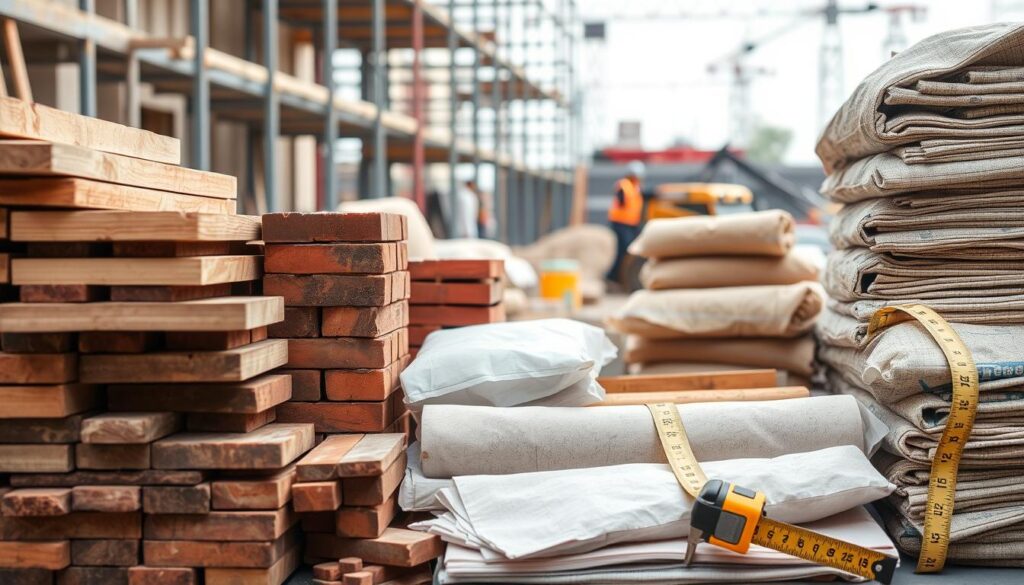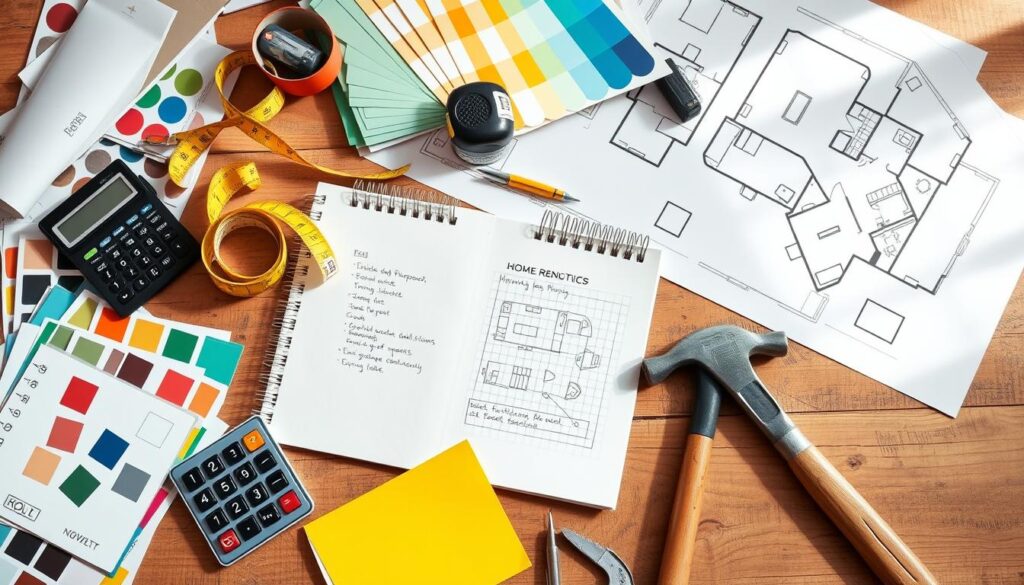Starting a home improvement project is both thrilling and scary. Whether it’s a small fix or a big change, the costs can pile up fast. But, with good planning and budgeting, you can make your dream a reality without breaking the bank. This guide will show you how to make a budget for your next home project.
Understanding the Basics of Home Improvement Budgeting
Starting a home renovation project is exciting, but knowing the costs is key. We’ll look at different renovation types, important financial terms, and how to set budget goals.
Different Types of Home Improvement Projects
Home improvement projects vary from small updates to big changes. Some common ones include:
- Kitchen and bathroom remodels
- Additions or expansions
- Roof replacements or repairs
- Exterior upgrades like siding, windows, or landscaping
- Energy-efficiency improvements like insulation or solar panel installation
Key Financial Terms You Should Know
To manage your home improvement budget, learn these financial terms:
- Budget: The total money set aside for your project.
- Contingency Fund: A part of your budget for unexpected costs.
- Loan-to-Value (LTV) Ratio: The loan amount compared to your home’s value.
- Interest Rate: The loan’s interest rate, affecting your monthly payments.
Setting Realistic Financial Goals
Setting realistic budget goals is vital for your project. Think about your finances, the project’s size, and financing options. Clear goals help keep your renovation on budget and on track.
“A well-planned budget is the foundation of a successful home improvement project.” – Jane Doe, Financial Advisor
Assessing Your Current Financial Situation
Before starting your next home improvement project, it’s key to do a detailed financial assessment. This means looking closely at your income and expenses. It helps you figure out how much you can spend on the project.
First, collect all your financial info. This includes your monthly income, fixed costs like rent or mortgage, and variable costs like utilities and groceries. Also, think about any debts or savings you have. This income evaluation and expense tracking will show you your financial situation. It helps you decide how much to budget for your home improvement.
| Financial Metric | Current Status |
|---|---|
| Monthly Income | $5,000 |
| Fixed Expenses | $2,500 |
| Variable Expenses | $1,500 |
| Existing Debts | $10,000 |
| Savings | $8,000 |
By carefully looking at your financial assessment, you can decide how much to spend on your project. This way, you won’t risk your financial stability.
“Budgeting for a home improvement project requires a meticulous financial assessment to ensure you don’t overextend your resources.”
Determining Project Scope and Priorities
When planning a home improvement project, it’s key to define its scope and prioritize tasks. This ensures your renovation stays on schedule and your budget is managed well. By focusing on essential tasks first, you can use resources wisely and meet your must-have needs.
Essential vs. Cosmetic Improvements
Essential home improvements tackle critical issues like structure, safety, and function. These include roof repairs, electrical upgrades, and plumbing work. Cosmetic improvements, however, focus on looks, like painting, updating fixtures, or new flooring.
Creating a Project Timeline
Creating a realistic project timeline is crucial for successful renovations. It involves breaking work into phases, planning for material delivery, and scheduling contractors. A good timeline helps you spot potential delays and adjust your budget and expectations.
Identifying Must-Have Features
When defining your project, identify the essential features you need. These could be specific finishes, appliances, or design elements you can’t live without. Prioritizing these ensures your renovation meets your long-term goals.
| Essential Improvements | Cosmetic Improvements |
|---|---|
| Roof repair | Repainting walls |
| Electrical upgrades | Updating fixtures |
| Plumbing overhaul | Installing new flooring |
Researching Material Costs and Labor Expenses
When planning a home improvement project, it’s key to know the costs of materials and labor. Doing thorough research helps you budget better and avoid surprises. Let’s look at how to assess these important factors.
Comparing Construction Material Prices
The cost of construction materials changes a lot. It depends on the supplier, brand, and market. Here are some tips to find the best deals:
- Get price quotes from different local and online suppliers for what you need.
- Compare prices and watch for sales or seasonal changes that might affect your budget.
- Think about the quality and durability of materials to get the most value.
Estimating Contractor Fees
Labor costs are a big part of your budget. Here are some tips for contractor fees:
- Get quotes from several licensed and insured contractors in your area.
- Ask each contractor to break down their labor costs, including hourly rates or flat fees.
- Find out about any extra fees, like for permits, disposal, or special equipment.
| Material | Average Cost per Unit | Estimated Quantity Needed | Total Cost |
|---|---|---|---|
| Hardwood Flooring | $5 per sq ft | 1,200 sq ft | $6,000 |
| Paint | $25 per gallon | 20 gallons | $500 |
| Countertops | $50 per sq ft | 60 sq ft | $3,000 |
By researching material and labor costs, you can make a detailed budget for your project. This helps you make smart choices and avoid financial surprises.

“Proper planning and research can make all the difference in the success of a home improvement project.”
Creating a Detailed Project Timeline
Making a detailed project timeline is key for a successful home renovation. This plan keeps your project on track and helps you deal with any challenges. It ensures you use resources well, coordinate contractors, and manage your project smoothly.
Planning for Seasonal Price Variations
When planning your home improvement budget, think about seasonal pricing. Prices for materials and labor can change with the seasons. Knowing this helps you budget better and adjust for any price changes.
Scheduling Contractors and Deliveries
It’s important to schedule contractors and material deliveries well. Create a detailed schedule for each project phase. This ensures you have what you need when you need it, avoiding delays.
Managing Project Phases
Break your project into clear phases for better organization. This lets you track progress and spot any issues early. Managing each phase well keeps your project on track and within budget.
“Careful planning and attention to detail are the keys to a successful home improvement project. By creating a detailed project timeline, you can minimize surprises and navigate your renovation with confidence.”
Setting Up an Emergency Fund Buffer
Starting a home improvement project means planning for the unexpected. Contingency planning helps you deal with any surprise costs or delays. Setting up an emergency fund is a smart way to protect your finances.
An emergency fund is a special savings account for unexpected expenses. It keeps your main renovation budget safe. This way, you can handle any surprises without ruining your project.
- Determine an appropriate buffer amount: Experts say to save 10-20% of your total budget for emergencies. The right amount depends on your project’s size and complexity.
- Prioritize building the emergency fund: Start saving for your emergency fund right away. You might need to cut back on some things or delay non-essential tasks. Being consistent is crucial for a strong financial cushion.
- Maintain the emergency fund: Keep an eye on your emergency fund and add to it as needed during the project. Try not to use it unless it’s really necessary. This way, it will be there when you need it most.
Having a solid emergency fund lets you handle the ups and downs of your project. You can focus on making your dream home a reality without worrying about surprise costs.

“The time to repair the roof is when the sun is shining.” – John F. Kennedy
Exploring Financing Options and Payment Plans
Getting the right financing is key for home renovations. Homeowners have several options, each with its own pros and cons. Let’s look at home equity loans and personal loans.
Home Equity Loans vs. Personal Loans
Home equity loans use your property’s value for lower interest rates. But, you need good credit and a lot of equity. Personal loans are unsecured and have higher rates. They might be easier to get if you have little equity or credit.
Understanding Interest Rates and Terms
Interest rates and terms affect your renovation’s cost. It’s vital to compare different options. Look at fixed or variable rates, repayment plans, and any fees or penalties.
Qualifying for Home Improvement Loans
Lenders check your credit, income, and debt when deciding on loans. Keeping your credit in good shape and your finances stable can help. This way, you might get better terms and lower rates.
| Loan Type | Average Interest Rates | Typical Loan Amounts | Key Considerations |
|---|---|---|---|
| Home Equity Loan | 4-8% | $50,000 – $250,000 | Requires home equity, lower interest rates |
| Personal Loan | 6-20% | $5,000 – $100,000 | Unsecured, higher interest rates, more accessible |
By carefully looking at your financing options, understanding the terms, and matching your project with your finances, you can make a smart choice. This will meet your renovation financing needs.
Finding Ways to Cut Costs Without Compromising Quality
Starting a home improvement project is thrilling, but it’s key to save money without losing quality. There are smart ways to do budget-friendly renovations. You can save a lot without giving up on the quality of your work.
One smart move is to focus on value engineering. This means picking materials and parts that offer great quality at a good price. By looking around and comparing, you can find better deals than usual.
- Look for ways to save, like buying in bulk or when prices are lower.
- Talk to contractors and suppliers to get the best deals on work and materials.
- Try DIY projects if you’re good at them. This can cut down on labor costs a lot.
For budget-friendly renovations, finding the right balance is key. Use smart strategies and value over just the cheapest price. This way, you can update your home without spending too much.
“The key to successful budget-friendly renovations is finding the sweet spot between cost-savings and quality craftsmanship.”
The aim is to make your home cozy, useful, and nice-looking without losing quality. With smart saving tips and value engineering, you can make your dream home a reality without sacrificing quality.
DIY vs Professional Work: Cost Analysis
Choosing between DIY and hiring pros for home projects affects your budget a lot. We’ll look at DIY skills, when to call in the pros, and the hidden costs of each.
Skills Assessment for DIY Projects
Before starting a DIY project, check if you’re skilled enough. Simple tasks like painting or basic plumbing might be okay. But, electrical work or big structural changes need pro skills.
When to Hire Professionals
DIY can save money, but some jobs need pros. Complex tasks, safety issues, and jobs needing special permits are best left to experts. They ensure the job is done right and saves you from costly errors.
Hidden Costs of Both Options
Both DIY and hiring pros have hidden costs. DIY might mean buying tools, waste disposal, and fixing mistakes. Hiring pros can have extra costs like permits, unexpected issues, and delays.
| Considerations | DIY Renovations | Professional Contractors |
|---|---|---|
| Skill Level | Requires assessment of personal skills and comfort level with the project | Experienced and qualified to handle complex tasks |
| Time Investment | Can be time-consuming, depending on the project | May be completed more efficiently by professionals |
| Cost | Can save money, but hidden costs may arise | May be more expensive upfront, but can prevent costly mistakes |
| Quality of Work | Depends on personal skills and attention to detail | Guarantee of high-quality, professional workmanship |
| Safety | Potential for safety risks if inexperienced | Safer approach with proper equipment and techniques |
When planning your next home project, think about DIY vs hiring pros. Know the skills needed, hidden costs, and when to get help. This way, you can choose wisely based on your budget and goals.
Conclusion
Starting your next home improvement project? The secret to success is in budgeting and planning. Knowing the types of projects, financial terms, and setting goals is key. This sets a strong base for your renovation.
First, check your finances, decide what’s most important, and look up costs. A detailed plan, an emergency fund, and financing options keep your project on track and affordable.
Looking for ways to save without losing quality is important. Weighing DIY versus hiring pros can greatly impact your budget recap, financial planning, and successful home improvement goals.
FAQ
How do I create a realistic budget for my home improvement project?
To start, look at your current money situation. This includes your income, what you spend, and how much you save. Next, figure out what you want to do with your project and how important it is.
Then, find out how much materials and labor will cost. Don’t forget to save some money for unexpected things. Look into financing options and find ways to save money without lowering the quality of your project.
What are the different types of home improvement projects?
Home improvement projects can be anything from fixing things to making them look better. Some common projects are redoing kitchens and bathrooms, adding on to your house, landscaping, and making your home more energy-efficient.
How do I know if I should tackle a project myself or hire professionals?
Think about your skills and the project’s complexity. If it’s simple, you can do it yourself. But for harder tasks or things that need special skills, it’s best to hire someone.
What financial terms should I understand when planning a home improvement project?
It’s important to know about interest rates, loan terms, and what you need to qualify for credit. Also, understand the costs of materials and labor, and how to plan for unexpected expenses.
How can I find ways to cut costs without compromising the quality of my home improvement project?
Save on materials by buying at the right time and negotiating prices. Choose affordable options that still look good. Focus on changes that will make a big difference in your home.
Try doing simple tasks yourself to save on labor costs. This can help you spend less without sacrificing quality.
How do I create a detailed project timeline?
When making a timeline, think about when prices change, when contractors are available, and the order of your project. Add extra time for any surprises that might happen.
What should I consider when setting financial goals for my home improvement project?
When setting goals, think about your budget, the project’s size, and how long you want it to take. Set realistic targets for costs and financing needs. Make sure to save for unexpected expenses.


